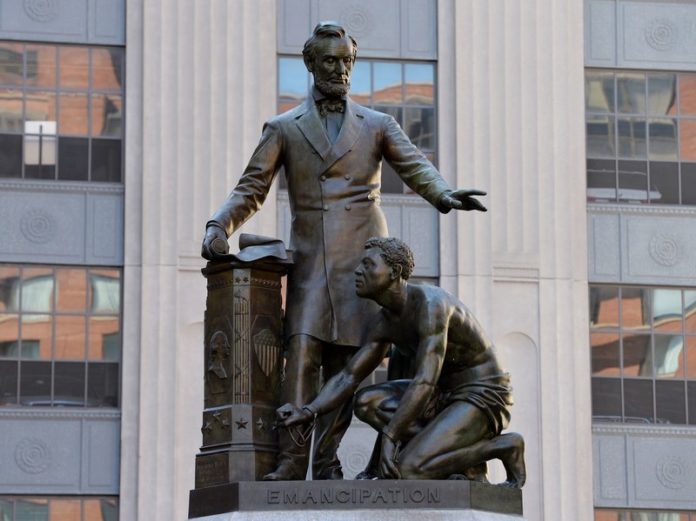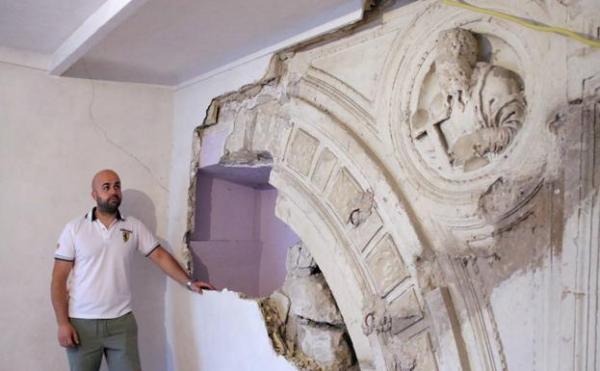
Lincoln statue with a slave at his feet was removed in Boston. Workers dismantled a statue of Abraham Lincoln in Boston on Tuesday after the city agreed with protesters who said the memorial was demeaning and lacking proper context. The Lincoln monument in Boston depicts the former American president holding his hand over a kneeling black man, a figure modeled after Archer Alexander, the last man to be captured under the Fugitive Slave Act.
“We’re delighted to have it removed this morning,” Boston Mayor Spokesman Marty Walsh said in a statement to NPR. He noted that the decision came after two public hearings and a petition by artist Tory Bullock in which 12,000 people supported to move Lincoln statue Boston.
Boston artist Tory Bullock started the petition. She described it this way: “I have watched this man kneeling since childhood. He is supposed to represent freedom, but instead, he represents us as still below someone else. She added that she has always asked herself, “If he’s free, why is he still kneeling?”
The Lincoln monument in Boston, which has stood in Park Square since 1879, is a replica of the Thomas Ball monument that still stands in Lincoln Park in Washington, D.C. The original work, which became known as the Emancipation Group, was bought with donations from liberated enslaved people and black veterans of the Union army. A copy of it was installed in Boston, Ball’s hometown.
The Boston Art Commission voted to remove the prominent Lincoln statue six months ago, as protesters against racial injustice called for either the complete demolition of the controversial monuments or placement in a new historical context.
The mayor’s office said the decision to remove it recognized the statue’s role in preserving harmful prejudices and covering up the role of black Americans in shaping the nation’s freedoms.
According to the National Park Service, the creation of the original statue came about the morning after Lincoln’s death in 1865, when Charlotte Scott, a former enslaved Virginia woman living in Ohio, asked her employer to send $ 5 to build a Lincoln monument in Boston.
The fundraising campaign raised thousands of dollars, but the design and commissioning of the Lincoln statue Boston were overseen by a white-run military aid agency called the Western Sanitary Commission. Even Frederick Douglas, who spoke at the unveiling of the monument in Washington, DC, in 1876, expressed doubts about the statue.
“As adorable as the monument to Mr. Ball in Lincoln Park is, it doesn’t seem to tell the whole truth to me,” Douglas wrote in a letter that became known this summer. He continued: “And perhaps no monument can be created to tell the whole truth about any subject that it might be intended to illustrate.”
Douglas noted that the Lincoln monument in Boston does not mention the role of President Ulysses S. Grant in granting civil rights to formerly enslaved people. He also said that memorials should strive to portray black people in a new light.

“The Negro here, though he gets up, is still kneeling and naked,” wrote Douglas. “The Negro here, though he gets up, is still kneeling and naked,” wrote Douglas.”Before I die, I want to see a monument depicting a black man who does not sit on his knees like a four-legged animal, but stands on his feet like a man.”
Similar sentiments were heard in Washington and elsewhere in the summer of 2020, as protests and debates erupted over how best to portray markers of America’s troubled history of racial discrimination and inequality. In June, lots of people gathered in Lincoln Park. They discussed what should happen to the Lincoln statue Boston.

(Gillian Brockell/twp)
Boston’s plans for the statue are still underway; the mayor’s office says the work will be moved to “a public place where its history and context can be better explained.” The city asks the public to submit ideas on how to erect the monument.
The original statue in the Capitol Hill area in Washington was also criticized during the summer demonstrations following the police assassination of George Floyd.
The officials placed the Lincoln statue under police protection. They surrounded it with protective barriers. The officials placed the Lincoln statue under police protection. They surrounded it with protective barriers. This is because a group of demonstrators destroyed a statue of former Confederate Albert Pike nearby. They threatened to do the same with the Lincoln statue.
After that, the residents hung up notes to the fence, in which they expressed their views; a few months later the fence was removed.
The Emancipation Monument was commissioned and paid for by a group of black Americans, many of whom had previously been enslaved. But the group had no say in the design of the statue; this distinction went to the all-white committee and the painter Ball, who was white.
It was dedicated on April 14, 1876, the 11th anniversary of Lincoln’s assassination, in front of a crowd of 25,000. It included then-President, Ulysses S. Grant. Abolitionist Frederick Douglas spoke at the opening ceremony, noting that the “Great Liberator” Lincoln did not want to free the enslaved people, and when he did, it only applied to the enslaved people in the Confederate states. Enslaved people in most of the allied states were not released until December 1865.
The black man who modeled Ball, Archer Alexander, was not freed by Lincoln, but by his own actions. As the Washington Post correspondent DeNin L. Brown wrote earlier this year, Alexander broke free of captivity in the middle of the night of 1861. He repeatedly evaded capture by former enslavers.
A few days after the opening, Douglas was the first to criticize the statue and suggest that it be replaced or added in a letter to the editor of the National Republican Gazette. The letter was recently rediscovered by historians Jonathan W. White and Scott A. Sandage.
The delegation of Eleanor Holmes Norton (Germany) passed a law to move the statue to the museum. Since it is located on federal land, it is run by the National Park Service, not the county. Norton plans to determine whether Parks Service has the authority to remove it without congressional approval, she said.
“Although previously enslaved Americans paid for this statue, which was built in 1876, the design and sculpting process was carried out without their participation, and it shows,” she said in a June statement.
























